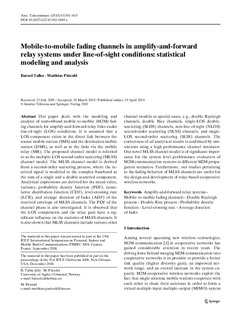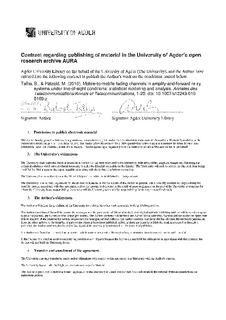| dc.contributor.author | Talha, Batool | |
| dc.contributor.author | Pätzold, Matthias | |
| dc.date.accessioned | 2010-11-19T12:40:14Z | |
| dc.date.available | 2010-11-19T12:40:14Z | |
| dc.date.issued | 2010 | |
| dc.identifier.citation | Talha, B., & Pätzold, M. (2010). Mobile-to-mobile fading channels in amplify-and-forward relay systems under line-of-sight conditions: statistical modeling and analysis. Annales des Telecommunications/Annals of Telecommunications, 65, 391-410. doi: 10.1007/s12243-010-0169-z | en_US |
| dc.identifier.issn | 0003-4347 | |
| dc.identifier.uri | http://hdl.handle.net/11250/139674 | |
| dc.description | Published version of an article from the journal:Annales des Telecommunications/Annals of Telecommunications. The original publication is available at Springerlink. http://dx.doi.org/10.1007/s12243-010-0169-z | en_US |
| dc.description.abstract | This paper deals with the modeling and analysis of narrowband mobile-to-mobile (M2M) fading channels for amplify-and-forward relay links under line-of-sight (LOS) conditions. It is assumed that a LOS component exists in the direct link between the source mobile station (SMS) and the destination mobile station (DMS), as well as in the links via the mobile relay (MR). The proposed channel model is referred to as the multiple-LOS second-order scattering (MLSS) channel model. The MLSS channel model is derived from a second-order scattering process, where the received signal is modeled in the complex baseband as the sum of a single and a double scattered component. Analytical expressions are derived for the mean value, variance, probability density function (PDF), cumulative distribution function (CDF), level-crossing rate (LCR), and average duration of fades (ADF) of the received envelope of MLSS channels. The PDF of the channel phase is also investigated. It is observed that the LOS components and the relay gain have a significant influence on the statistics of MLSS channels. It is also shown that MLSS channels include various other channel models as special cases, e.g., double Rayleigh channels, double Rice channels, single-LOS double-scattering (SLDS) channels, non-line-of-sight (NLOS) second-order scattering (NLSS) channels, and single-LOS second-order scattering (SLSS) channels. The correctness of all analytical results is confirmed by simulations using a high performance channel simulator. Our novel MLSS channel model is of significant importance for the system level performance evaluation of M2M communication systems in different M2M propagation scenarios. Furthermore, our studies pertaining to the fading behavior of MLSS channels are useful for the design and development of relay-based cooperative wireless networks. © 2010 Institut Télécom and Springer-Verlag. | en_US |
| dc.language.iso | eng | en_US |
| dc.publisher | Springer | en_US |
| dc.title | Mobile-to-mobile fading channels in amplify-and-forward relay systems under line-of-sight conditions: statistical modeling and analysis | en_US |
| dc.type | Journal article | en_US |
| dc.type | Peer reviewed | en_US |
| dc.subject.nsi | VDP::Mathematics and natural science: 400::Information and communication science: 420::Communication and distributed systems: 423 | en_US |
| dc.subject.nsi | VDP::Technology: 500::Information and communication technology: 550::Telecommunication: 552 | en_US |
| dc.source.pagenumber | 391-410 | en_US |

